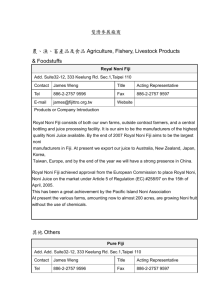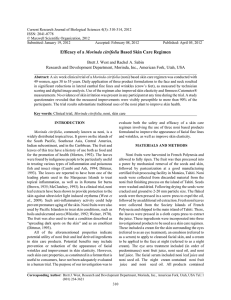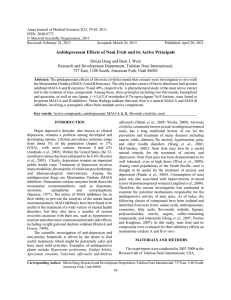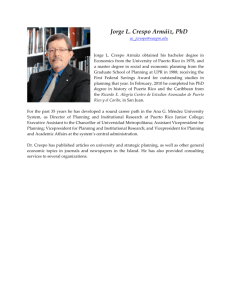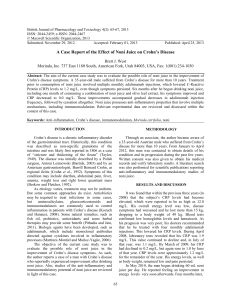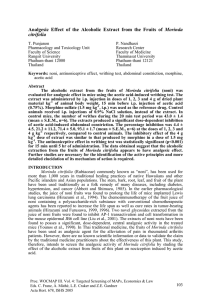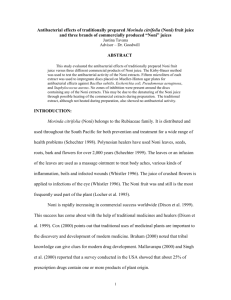Morinda citrifolia L. noni RUBIACEAE Synonyms: none
advertisement
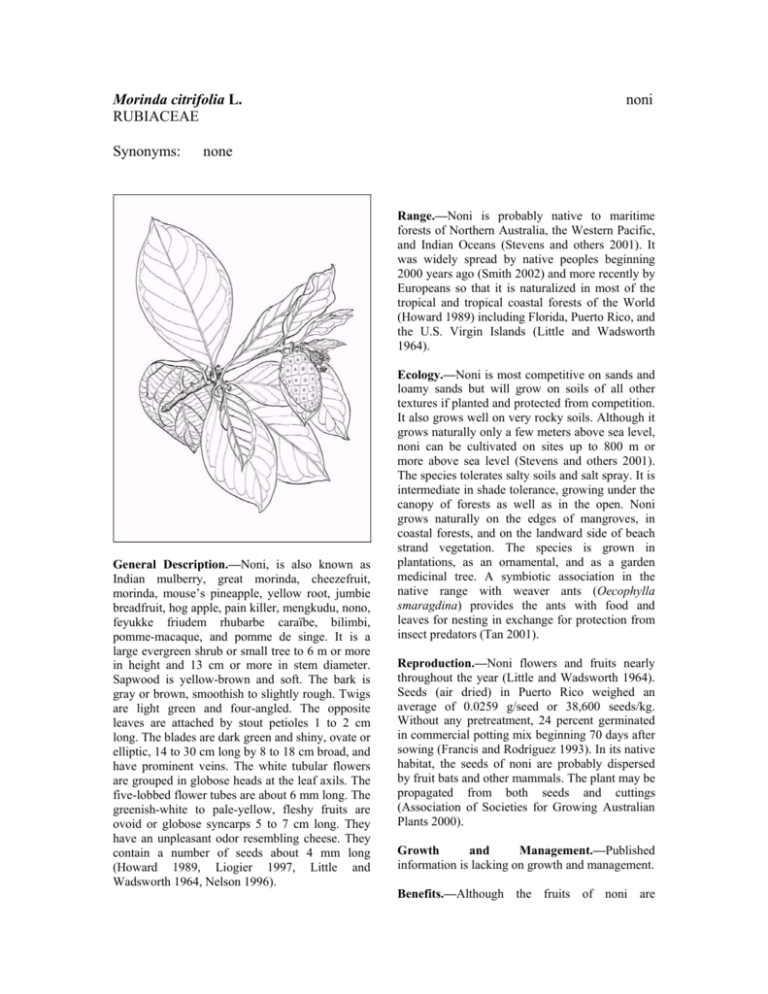
Morinda citrifolia L. RUBIACEAE Synonyms: noni none Range.—Noni is probably native to maritime forests of Northern Australia, the Western Pacific, and Indian Oceans (Stevens and others 2001). It was widely spread by native peoples beginning 2000 years ago (Smith 2002) and more recently by Europeans so that it is naturalized in most of the tropical and tropical coastal forests of the World (Howard 1989) including Florida, Puerto Rico, and the U.S. Virgin Islands (Little and Wadsworth 1964). General Description.—Noni, is also known as Indian mulberry, great morinda, cheezefruit, morinda, mouse’s pineapple, yellow root, jumbie breadfruit, hog apple, pain killer, mengkudu, nono, feyukke friudem rhubarbe caraïbe, bilimbi, pomme-macaque, and pomme de singe. It is a large evergreen shrub or small tree to 6 m or more in height and 13 cm or more in stem diameter. Sapwood is yellow-brown and soft. The bark is gray or brown, smoothish to slightly rough. Twigs are light green and four-angled. The opposite leaves are attached by stout petioles 1 to 2 cm long. The blades are dark green and shiny, ovate or elliptic, 14 to 30 cm long by 8 to 18 cm broad, and have prominent veins. The white tubular flowers are grouped in globose heads at the leaf axils. The five-lobbed flower tubes are about 6 mm long. The greenish-white to pale-yellow, fleshy fruits are ovoid or globose syncarps 5 to 7 cm long. They have an unpleasant odor resembling cheese. They contain a number of seeds about 4 mm long (Howard 1989, Liogier 1997, Little and Wadsworth 1964, Nelson 1996). Ecology.—Noni is most competitive on sands and loamy sands but will grow on soils of all other textures if planted and protected from competition. It also grows well on very rocky soils. Although it grows naturally only a few meters above sea level, noni can be cultivated on sites up to 800 m or more above sea level (Stevens and others 2001). The species tolerates salty soils and salt spray. It is intermediate in shade tolerance, growing under the canopy of forests as well as in the open. Noni grows naturally on the edges of mangroves, in coastal forests, and on the landward side of beach strand vegetation. The species is grown in plantations, as an ornamental, and as a garden medicinal tree. A symbiotic association in the native range with weaver ants (Oecophylla smaragdina) provides the ants with food and leaves for nesting in exchange for protection from insect predators (Tan 2001). Reproduction.—Noni flowers and fruits nearly throughout the year (Little and Wadsworth 1964). Seeds (air dried) in Puerto Rico weighed an average of 0.0259 g/seed or 38,600 seeds/kg. Without any pretreatment, 24 percent germinated in commercial potting mix beginning 70 days after sowing (Francis and Rodríguez 1993). In its native habitat, the seeds of noni are probably dispersed by fruit bats and other mammals. The plant may be propagated from both seeds and cuttings (Association of Societies for Growing Australian Plants 2000). Growth and Management.—Published information is lacking on growth and management. Benefits.—Although the fruits of noni are somewhat tasteless and have an unpleasant smell, they are eaten as famine food in Indonesia, Australia, and the Pacific Islands. The young leaves are also eaten as a vegetable and contain 4 to 6 percent protein. Noni is planted as a windbreak, for support of pepper vines, and shade for coffee bushes (Tan 2001). The species is useful for coastal erosion control (Association of Societies for Growing Australian Plants 2000), and it is planted as an ornamental in some areas. The bark has been the source of a red dye (Little and Wadsworth 1964). Roots are used to produce an orange dye (Nelson 1996). Harvested from both plantations and from the wild, noni is one of the most important botanical remedies and food supplements traded on the international market. It is usually the fruit juice that is sold, fresh or dried. Leaves, bark, and roots are also used for a great many maladies. Pain, arthritis, diabetes, high blood pressure, skin and stomach ulcers, depression, senility, diarrhea, arteriosclerosis, cancer, AIDS, skin parasites, and bad breath are all treated (Association of Societies for Growing Australian Plants 2000, Cambie and Ash 1994, Tan 2001). A number of physiologically active chemicals, anthraquinones, alkaloids, asperuloside, caproic, caprylic, and ursolic acids, β-sitosterol, and asperuloside may account for some of the effects (Cambie and Ash 1994). Antitumor activity expressed in enhanced survival of tumor-bearing mice has been demonstrated after treating with juice extracts (Hirazumi and Furusawa 1999). Aqueous extracts of roots were shown to have an analgesic effect on mice without any sign of toxicity, and a sedative effect at high doses (Younos and others 1990). Octanoic acid, which is present in the ripe fruits, effectively poisons a fruit fly (Drosophila melanogaster), honey bee (Apis mellifera), an ant (Lasius sp.), and cockroaches (Periplaneta americana and Blattella germanica) (Legal and Plawecki 1995). Noni is the principal larval host of the hawk moth, Macroglossum hirundo vitiensis in Fiji (Stampsfiji.com 2002). References Association of Societies for Growing Australian Plants. 2000. Morinda citrifolia. http:/farrer.csu.edu/ASGAP/m-cit.html. 2 p. Cambie, R.C. and J. Ash. 1994. Fijian medicinal plants. CSIRO, Canberra, Australia. 365 p. Francis, J.K. and A. Rodríguez. 1993. Seeds of Puerto Rican trees and shrubs: second installment. Research Note SO-374. U.S. Department of Agriculture, Forest Service, Southern Forest Experiment Station, New Orleans, LA. 5 p. Hirazumi, A. and E. Furusawa. 1999. An immunomodulatory polysaccharide-rich substance from the fruit juice of Morinda citrifolia (noni) with antitumour activity. Phytotherapy Research 13(5): 380-387. Howard, R.A. 1989. Flora of the Lesser Antilles, Leeward and Windward Islands. Dicotyledoneae. Part 3. Vol. 6. Arnold Arboretum, Harvard University, Jamaica Plain, MA. 658 p. Legal, L. and M. Plawecki. 1995. Comparative sensitivity of various insects to toxic compounds from Morinda citrifolia L. Entomological Problems 26(2): 155-159. Liogier, H.A. 1997. Descriptive flora of Puerto Rico and adjacent islands. Vol. 5. Editorial de la Universidad de Puerto Rico, San Juan, PR. 436 p. Little, E.L., Jr. and F.H. Wadsworth. 1964. Common trees of Puerto Rico and the Virgin Islands. Agriculture Handbook 249. U.S. Department of Agriculture, Forest Service, Washington, DC. 548 p. Nelson, G. 1996. The shrubs and woody vines of Florida. Pineapple Press, Sarasota, FL. 391 p. Smith, R.S. 2002. History and tradition of Morinda citrifolia. http://rsscomp.freeyellow. com/morindacitrifoliastory.htm. 2 p. Stampsfiji.com. 2002. The Sphingid (hawk) moths of Fiji stamp issue. http://www.stampsfiji. com/stamps/moths/ 4 p. Stevens, W.D., C. Ulloa U., A. Pool, and O. M. Montiel, eds. 2001. Flora de Nicaragua. Monographs in Systematic Botany Vol. 85, No. 3. Missouri Botanic Garden, St. Louis, MO. p. 1,911-2,664. Tan, R. 2001. Mangrove and wetland wildlife at Sungei Buloh Nature Park: Great morinda. http://www.naturia.per.sg/buloh/plants/morinda. htm. 3 p. Younos, C., A. Rolland, J. Fleurentin, M.C. Lanhers, R. Misslin, and F. Mortier. 1990. Analgesic and behavioral effects of Morinda citrifolia. Planta Medica 56(5): 430-434. _________________________________________ John K. Francis, Research Forester, U.S. Department of Agriculture, Forest Service, International Institute of Tropical Forestry, Jardín Botánico Sur, 1201 Calle Ceiba, San Juan PR 00926-1119, in cooperation with the University of Puerto Rico, Río Piedras, PR 00936-4984
